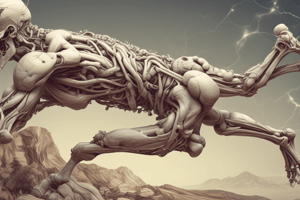Podcast
Questions and Answers
Which term describes the plane that divides the body into anterior and posterior parts?
Which term describes the plane that divides the body into anterior and posterior parts?
- Transverse Plane
- Frontal Plane (correct)
- Median Plane
- Sagittal Plane
What is the correct anatomical term for the space that contains the urinary bladder and part of the large intestine?
What is the correct anatomical term for the space that contains the urinary bladder and part of the large intestine?
- Pelvic Cavity (correct)
- Cranial Cavity
- Thoracic Cavity
- Abdominal Cavity
Which of the following sections cuts through an organ completely, similar to cutting a hot dog?
Which of the following sections cuts through an organ completely, similar to cutting a hot dog?
- Oblique Section
- Longitudinal Section
- Sagittal Section
- Cross Section (correct)
In anatomical terms, how would the skull be described in relation to the neck?
In anatomical terms, how would the skull be described in relation to the neck?
Which region is considered inferior to the umbilical region?
Which region is considered inferior to the umbilical region?
In anatomical terms, how are the right arm and left arm positioned in relation to each other?
In anatomical terms, how are the right arm and left arm positioned in relation to each other?
What anatomical term describes a cut made diagonally across the long axis of an organ?
What anatomical term describes a cut made diagonally across the long axis of an organ?
Which region of the abdomen is located on the left side and includes the spleen?
Which region of the abdomen is located on the left side and includes the spleen?
What does the term 'gross anatomy' refer to?
What does the term 'gross anatomy' refer to?
Which of the following correctly describes 'physiology'?
Which of the following correctly describes 'physiology'?
What is the basic structural and functional unit of organisms?
What is the basic structural and functional unit of organisms?
In anatomical position, how are the palms of the hands oriented?
In anatomical position, how are the palms of the hands oriented?
Which division refers to the lower limb extending from the hip to the knee?
Which division refers to the lower limb extending from the hip to the knee?
What is the primary characteristic of microscopic anatomy?
What is the primary characteristic of microscopic anatomy?
Which of the following quadrants is located in the upper right section of the abdomen?
Which of the following quadrants is located in the upper right section of the abdomen?
What term describes the grouping of organs that perform one or more common functions?
What term describes the grouping of organs that perform one or more common functions?
Flashcards are hidden until you start studying
Study Notes
Anatomy and Physiology
- Anatomy studies bodily structures; the term originates from Greek meaning "to cut apart."
- Physiology focuses on bodily processes and functions.
- Gross anatomy examines large structures visible without magnification; microscopic anatomy requires a microscope.
- Microscopic anatomy includes cytology (study of cells) and histology (study of tissues).
Levels of Organization
- Chemical: Interaction and combination of atoms into molecules.
- Cell: Basic structural and functional units of living organisms.
- Tissue: Groups of similar cells and surrounding materials.
- Organ: Composed of two or more tissue types functioning together.
- Organ System: Groups of organs that work as a unit due to common functions.
- Organism: Complex of organ systems mutually dependent on each other.
Organ Systems
- Integumentary
- Skeletal
- Muscular
- Nervous
- Endocrine
- Cardiovascular
- Lymphatic
- Respiratory
- Digestive
- Urinary
- Reproductive
Anatomical Position
- Defined as standing upright with the face forward, arms at the sides, palms facing forward.
- Supine position: lying face upward.
- Prone position: lying face downward.
- Central body regions include head, neck, trunk (thorax, abdomen, pelvis).
Body Parts and Regions
- Upper limb segments: arm (shoulder to elbow), forearm (elbow to wrist), wrist, hand.
- Lower limb segments: thigh (hip to knee), leg (knee to ankle), ankle, foot.
Abdominal Quadrants and Regions
- Abdomen divided into four quadrants: right-upper, left-upper, right-lower, left-lower using horizontal and vertical lines intersecting at the navel.
- Abdomen can also be divided into nine regions using four imaginary lines forming a tic-tac-toe grid:
- Epigastric
- Right and Left Hypochondriac
- Umbilical
- Right and Left Lumbar
- Hypogastric
- Right and Left Iliac
Anatomical Planes
- Transverse/Horizontal Plane: Divides the body into superior and inferior parts.
- Frontal/Coronal Plane: Divides the body into anterior and posterior parts.
- Sagittal Plane: Separates the body into right and left parts.
- Median Plane: Specific sagittal plane along the midline; divides the body into equal halves.
- Parasagittal Plane: An uneven sagittal plane.
Sections of Organs
- Longitudinal: Cut along the length of an organ.
- Transverse/Cross Section: Cut completely through an organ, similar to slicing a hot dog.
- Oblique: Diagonal cut across the long axis of an organ.
Trunk Cavities
- Thoracic Cavity: Enclosed by the rib cage, separated from the abdominal cavity by the diaphragm.
- Abdominal Cavity: Bounded by abdominal muscles, containing organs like stomach, intestines, liver, spleen, pancreas, and kidneys.
- Pelvic Cavity: Enclosed by pelvic bones, contains urinary bladder, part of large intestine, and reproductive organs.
Fun Questions (Terms and Relationships)
- Superior, inferior, anterior, posterior, lateral, medial, proximal, distal, superficial, deep, ipsilateral, contralateral are anatomical terms indicating locations and relationships between body parts.
Studying That Suits You
Use AI to generate personalized quizzes and flashcards to suit your learning preferences.





